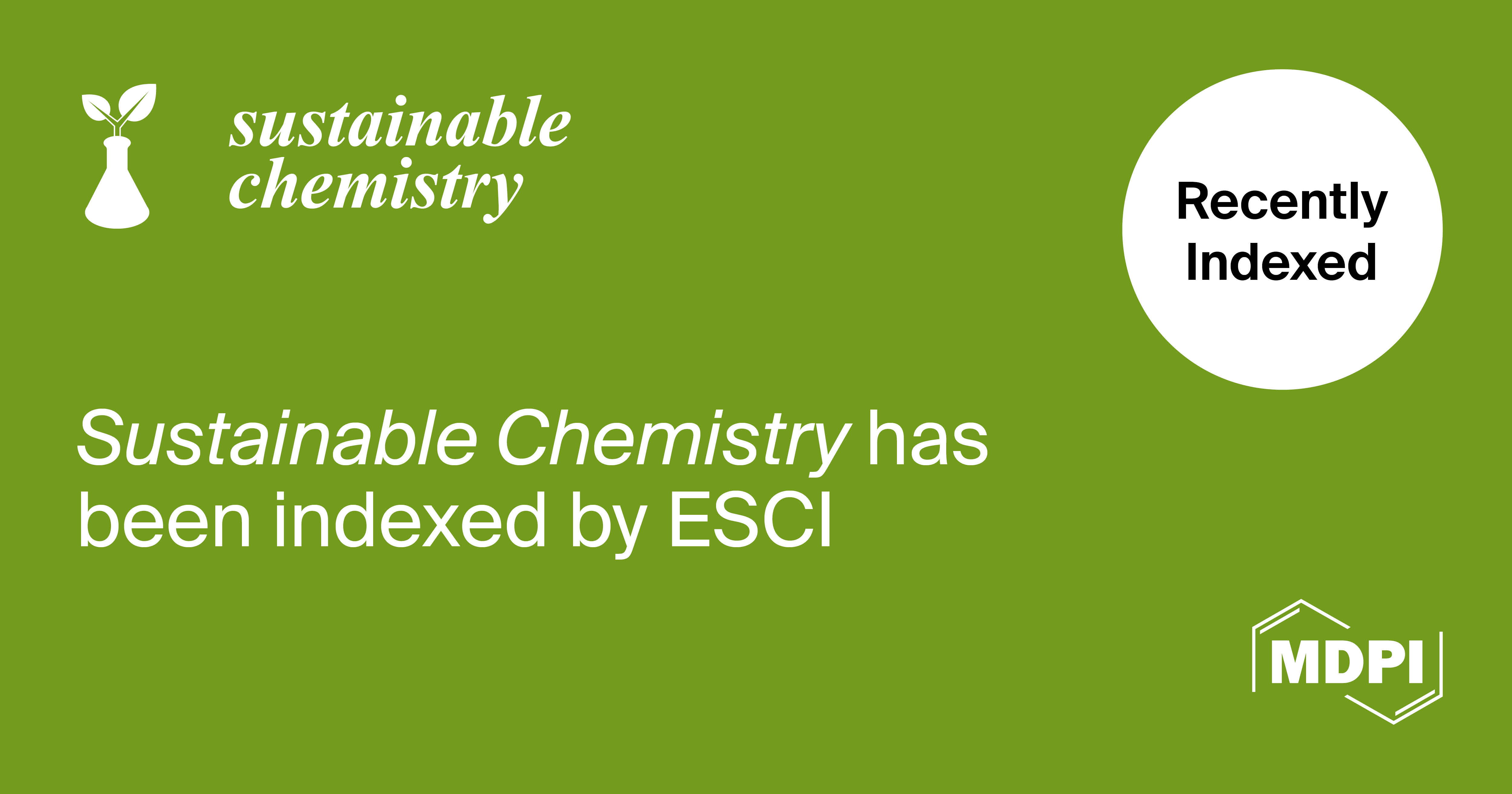Journal Description
Sustainable Chemistry
Sustainable Chemistry
is an international, peer-reviewed, open access journal on advances in the development of alternative green and sustainable technologies in chemical engineering, published quarterly online by MDPI.
- Open Access— free for readers, with article processing charges (APC) paid by authors or their institutions.
- High Visibility: indexed within ESCI (Web of Science), CAPlus / SciFinder, FSTA, and other databases.
- Rapid Publication: manuscripts are peer-reviewed and a first decision is provided to authors approximately 29.1 days after submission; acceptance to publication is undertaken in 3.7 days (median values for papers published in this journal in the second half of 2023).
- Recognition of Reviewers: APC discount vouchers, optional signed peer review, and reviewer names published annually in the journal.
- Sustainable Chemistry is a companion journal of Sustainability.
Latest Articles
Sustainable Technological Applications of Green Carbon Materials
Sustain. Chem. 2024, 5(2), 81-97; https://doi.org/10.3390/suschem5020007 - 01 Apr 2024
Abstract
►
Show Figures
Green carbon-based materials (GCM), i.e., carbon materials produced using renewable biomass or recycled waste, ought to be used to make processes sustainable and carbon-neutral. Carbon nanomaterials, like carbon dots and the nanobichar families, and carbon materials, like activated carbon and biochar substances, are
[...] Read more.
Green carbon-based materials (GCM), i.e., carbon materials produced using renewable biomass or recycled waste, ought to be used to make processes sustainable and carbon-neutral. Carbon nanomaterials, like carbon dots and the nanobichar families, and carbon materials, like activated carbon and biochar substances, are sustainable materials with great potential to be used in different technological applications. In this review, the following four applications were selected, and the works published in the last two years (since 2022) were critically reviewed: agriculture, water treatment, energy management, and carbon dioxide reduction and sequestration. GCM improved the performance of the technological applications under revision and played an important role in the sustainability of the processes, contributing to the mitigation of climate change, by reducing emissions and increasing the sequestration of CO2eq.
Full article
Open AccessArticle
Isolation of Cardanol Fractions from Cashew Nutshell Liquid (CNSL): A Sustainable Approach
by
Bhavika Bhatia, Nagarjuna Amarnath, Sumit K. Rastogi and Bimlesh Lochab
Sustain. Chem. 2024, 5(2), 68-80; https://doi.org/10.3390/suschem5020006 - 01 Apr 2024
Abstract
Exploring sustainable approaches to replace petroleum-based chemicals is an ongoing challenge in reducing the carbon footprint. Due to the complexity and percentage variation in nature-generated molecules, which further varies based on geographical origin and the purification protocol adopted, a better isolation strategy for
[...] Read more.
Exploring sustainable approaches to replace petroleum-based chemicals is an ongoing challenge in reducing the carbon footprint. Due to the complexity and percentage variation in nature-generated molecules, which further varies based on geographical origin and the purification protocol adopted, a better isolation strategy for individual components is required. Agrowaste from the cashew industry generates phenolic lipid (cardanol)-rich cashew nutshell liquid (CNSL) and has recently shown extensive commercial utility. Cardanol naturally exists as a mixture of three structurally different components with C15-alkylene chains: monoene, diene, and triene. The separation of these three fractions has been a bottleneck and is crucial for certain structural designs and reproducibility. Herein, we describe the gram-scale purification of cardanol into each component using flash column chromatography within the sustainability framework. The solvent used for elution is recovered and reused after each stage (up to 82%), making it a cost-effective and sustainable purification strategy. This simple purification technique replaces the alternative high-temperature vacuum distillation, which requires substantial energy consumption and poses vacuum fluctuation and maintenance challenges. Three components (monoene 42%, diene 22%, and triene 36%) were isolated with good purity and were fully characterized by 1H and 13C NMR, GC-MS, HPLC, and FTIR spectroscopy. The present work demonstrates that greener and simpler strategies pave the way for the isolation of constituents from nature-sourced biochemicals and unleash the potential of CNSL-derived fractions for high-end applications.
Full article
(This article belongs to the Special Issue Efficient and Ecofriendly Chemical Synthesis of Advanced Materials for Energy and Environment)
►▼
Show Figures
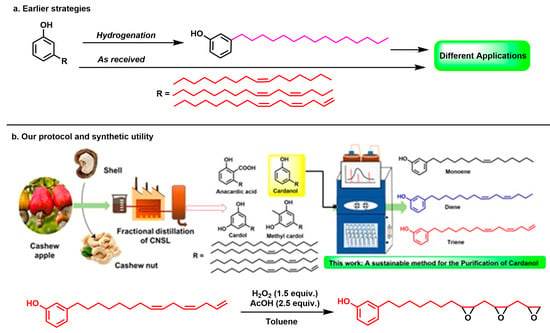
Figure 1
Open AccessPerspective
Sustainable-by-Design Approach of Active Catalysts to Produce Reactive Oxygen Species in Water Matrices
by
Prisco Prete
Sustain. Chem. 2024, 5(2), 60-67; https://doi.org/10.3390/suschem5020005 - 29 Mar 2024
Abstract
An overview of the latest advances in the design of active catalysts with the ability to promote (photo) Fenton processes in water from a Green Chemistry perspective is discussed herein. A critical evaluation of the most relevant advances has been disclosed, and a
[...] Read more.
An overview of the latest advances in the design of active catalysts with the ability to promote (photo) Fenton processes in water from a Green Chemistry perspective is discussed herein. A critical evaluation of the most relevant advances has been disclosed, and a brief perspective is presented about what is needed to fill the gap of knowledge in this field.
Full article
(This article belongs to the Special Issue Innovations in Energy Engineering and Cleaner Production: A Sustainable Chemistry Perspective)
Open AccessReview
The Multifaceted Perspective on the Role of Green Synthesis of Nanoparticles in Promoting a Sustainable Green Economy
by
Manish Kumar Sah, Biraj Shah Thakuri, Jyoti Pant, Ramesh L. Gardas and Ajaya Bhattarai
Sustain. Chem. 2024, 5(2), 40-59; https://doi.org/10.3390/suschem5020004 - 25 Mar 2024
Abstract
►▼
Show Figures
The current economic development paradigm, which is based on steadily rising resource consumption and pollution emissions, is no longer viable in a world with limited resources and ecological capacity. The “green economy” idea has presented this context with a chance to alter how
[...] Read more.
The current economic development paradigm, which is based on steadily rising resource consumption and pollution emissions, is no longer viable in a world with limited resources and ecological capacity. The “green economy” idea has presented this context with a chance to alter how society handles the interplay between the environmental and economic spheres. The related concept of “green nanotechnology” aims to use nano-innovations within the fields of materials science and engineering to generate products and processes that are economically and ecologically sustainable, enabling society to establish and preserve a green economy. Many different economic sectors are anticipated to be impacted by these applications, including those related to corrosion inhibitor nanofertilizers, nanoremediation, biodegradation, heavy metal detection, biofuel, insecticides and pesticides, and catalytic CO2 reduction. These innovations might make it possible to use non-traditional water sources safely and to create construction materials that are enabled by nanotechnology, improving living and ecological conditions. Therefore, our aim is to highlight how nanotechnology is being used in the green economy and to present promises for nano-applications in this domain. In the end, it emphasizes how critical it is to attain a truly sustainable advancement in nanotechnology.
Full article
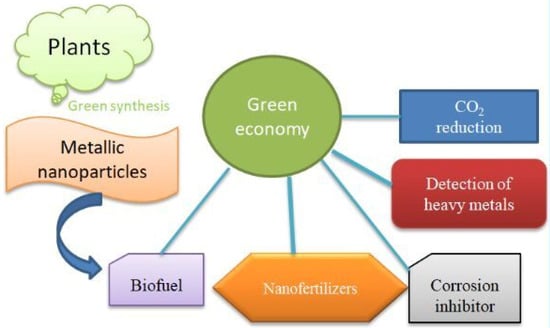
Figure 1
Open AccessReview
Recent Progress in Turning Waste into Catalysts for Green Syntheses
by
Konstantin Wink and Ingo Hartmann
Sustain. Chem. 2024, 5(1), 27-39; https://doi.org/10.3390/suschem5010003 - 16 Mar 2024
Abstract
►▼
Show Figures
The recycling of catalysts has emerged as a key solution to address environmental pollution and the scarcity of natural resources. This dynamic is further reinforced by the growing industrial demand for catalysts and the urgent need to transition to more sustainable production methods.
[...] Read more.
The recycling of catalysts has emerged as a key solution to address environmental pollution and the scarcity of natural resources. This dynamic is further reinforced by the growing industrial demand for catalysts and the urgent need to transition to more sustainable production methods. In the context of chemical transformations, the direct reuse of recycled catalysts for chemical applications in particular represents an elegant route towards greener syntheses. In this article, we review recent advancements in the recycling of homogeneous and heterogeneous catalysts since 2020, emphasizing the utilization of waste-derived catalysts for chemical reactions. In particular, we consider three primary sources of waste: electronic waste, spent lithium-ion batteries, and industrial wastewater. For each of these waste streams, different extraction methods are explored for their effectiveness in obtaining catalysts suitable for a broad spectrum of chemical reactions. These presented studies emphasize the potential of recycled catalysts to contribute to a sustainable and waste-efficient future.
Full article
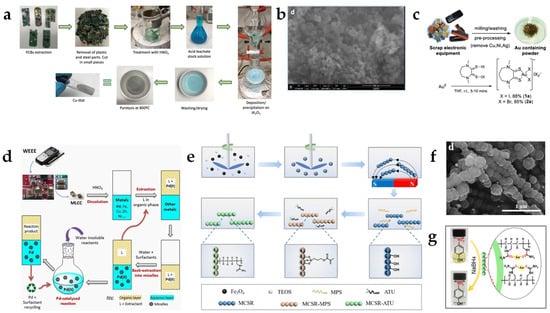
Figure 1
Open AccessPerspective
A Perspective on Solar-Driven Electrochemical Routes for Sustainable Methanol Production
by
Aaditya Pendse and Aditya Prajapati
Sustain. Chem. 2024, 5(1), 13-26; https://doi.org/10.3390/suschem5010002 - 06 Mar 2024
Abstract
The transition towards sustainable and renewable energy sources is imperative in mitigating the environmental impacts of escalating global energy consumption. Methanol, with its versatile applications and potential as a clean energy carrier, a precursor chemical, and a valuable commodity, emerges as a promising
[...] Read more.
The transition towards sustainable and renewable energy sources is imperative in mitigating the environmental impacts of escalating global energy consumption. Methanol, with its versatile applications and potential as a clean energy carrier, a precursor chemical, and a valuable commodity, emerges as a promising solution within the realm of renewable energy technologies. This work explores the integration of electrochemistry with solar power to drive efficient methanol production processes, focusing on electrochemical reduction (ECR) of CO2 and methane oxidation reaction (MOR) as pathways for methanol synthesis. Through detailed analysis and calculations, we evaluate the thermodynamic limits and realistic solar-to-fuel (STF) efficiencies of ECR and MOR. Our investigation encompasses the characterization of multijunction light absorbers, determination of thermoneutral potentials, and assessment of STF efficiencies under varying conditions. We identify the challenges and opportunities inherent in both ECR and MOR pathways, shedding light on catalyst stability, reaction kinetics, and system optimization, thereby providing insights into the prospects and challenges of solar-driven methanol synthesis, offering a pathway towards a cleaner and more sustainable energy future.
Full article
(This article belongs to the Special Issue Innovations in Energy Engineering and Cleaner Production: A Sustainable Chemistry Perspective)
►▼
Show Figures

Figure 1
Open AccessArticle
Waste Lignocellulosic Biomass as a Source for Bioethanol Production
by
Klemen Rola, Sven Gruber, Darko Goričanec and Danijela Urbancl
Sustain. Chem. 2024, 5(1), 1-12; https://doi.org/10.3390/suschem5010001 - 28 Feb 2024
Abstract
Synthetically produced biofuels play a critical role in the energy transition away from fossil fuels. Biofuels could effectively lower greenhouse gas (GHG) emissions and contribute to better air quality. One of these biofuels is bioethanol, which could act as a gasoline replacement. For
[...] Read more.
Synthetically produced biofuels play a critical role in the energy transition away from fossil fuels. Biofuels could effectively lower greenhouse gas (GHG) emissions and contribute to better air quality. One of these biofuels is bioethanol, which could act as a gasoline replacement. For this purpose, a simulation of bioethanol production through lignocellulosic biomass fermentation, focused on distillation, was carried out in simulation software Aspen Plus. Since the possibility of absolute ethanol production through distillation is limited by the ethanol–water azeotrope, pressure swing distillation (PSD) was used to obtain fuel-grade ethanol (EtOH) with a fraction of 99.60 wt.%. The flowsheet was optimised with NQ analysis, which is a simple optimisation method for distillation columns. We found that the PSD has the potential to concentrate the EtOH to a desired value, while simultaneously removing other unwanted impurities whose presence is a consequence of pretreatment and fermentation processes.
Full article
(This article belongs to the Topic Biomass Transformation: Sustainable Development)
►▼
Show Figures
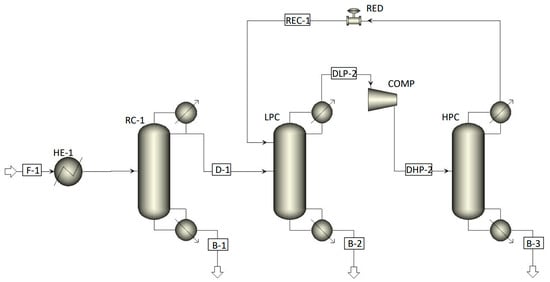
Figure 1
Open AccessReview
Envisioning a BHET Economy: Adding Value to PET Waste
by
Clarissa C. Westover and Timothy E. Long
Sustain. Chem. 2023, 4(4), 363-393; https://doi.org/10.3390/suschem4040025 - 18 Dec 2023
Cited by 2
Abstract
Poly(ethylene terephthalate), the fifth most produced polymer, generates significant waste annually. This increased waste production has spurred interest in chemical and mechanical pathways for recycling. The shift from laboratory settings to larger-scale implementation creates opportunities to explore the value and recovery of recycling
[...] Read more.
Poly(ethylene terephthalate), the fifth most produced polymer, generates significant waste annually. This increased waste production has spurred interest in chemical and mechanical pathways for recycling. The shift from laboratory settings to larger-scale implementation creates opportunities to explore the value and recovery of recycling products. Derived from the glycolysis of PET, bis(2-hydroxyethyl) terephthalate (BHET) exhibits versatility as a depolymerization product and valuable monomer. BHET exhibits versatility and finds application across diverse industries such as resins, coatings, foams, and tissue scaffolds. Incorporating BHET, which is a chemical recycling product, supports higher recycling rates and contributes to a more sustainable approach to generating materials. This review illuminates the opportunities for BHET as a valuable feedstock for a more circular polymer materials economy.
Full article
(This article belongs to the Topic Green and Sustainable Chemistry)
►▼
Show Figures
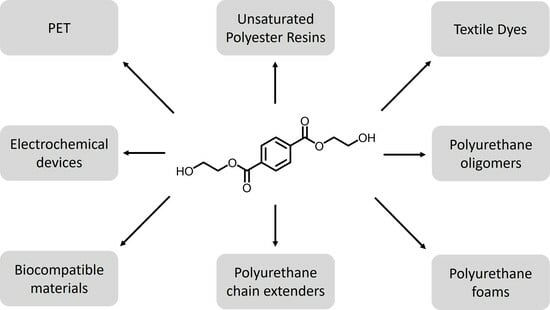
Graphical abstract
Open AccessReview
Polyfluoroalkyl Substances (PFASs) Detection Via Carbon Dots: A Review
by
Ricardo M. S. Sendão, Joaquim C. G. Esteves da Silva and Luís Pinto da Silva
Sustain. Chem. 2023, 4(4), 339-362; https://doi.org/10.3390/suschem4040024 - 15 Dec 2023
Abstract
►▼
Show Figures
PFASs are a class of highly persistent chemicals that are slowly infiltrating soils and waterways. Thus, there is a great need for fast, sensitive, and reliable techniques to detect PFASs. Conventional methods, such as LC-MS/SPE, allow high sensitivities. However, such methods can be
[...] Read more.
PFASs are a class of highly persistent chemicals that are slowly infiltrating soils and waterways. Thus, there is a great need for fast, sensitive, and reliable techniques to detect PFASs. Conventional methods, such as LC-MS/SPE, allow high sensitivities. However, such methods can be complex and expensive. Considering this, it is not surprising that the scientific community has turned their attention to the search for alternatives. New types of PFAS sensors have been reported over the years, being generally part of three classes: optical, electrochemical, or hybrid sensors. Carbon dots (CDs) are new alternative fluorescent sensors that can present great affinity towards PFASs, while allowing for a fast response and promising sensitivity and selectivity. Furthermore, CDs have more attractive properties than traditional fluorophores and even metal-based nanomaterials that make them better candidates for sensing applications. Thus, CDs display great potential for permitting a fast and accurate quantification of PFASs. This review aims to serve as a basis for the future development and optimization of CD-based fluorescent sensors for PFASs.
Full article
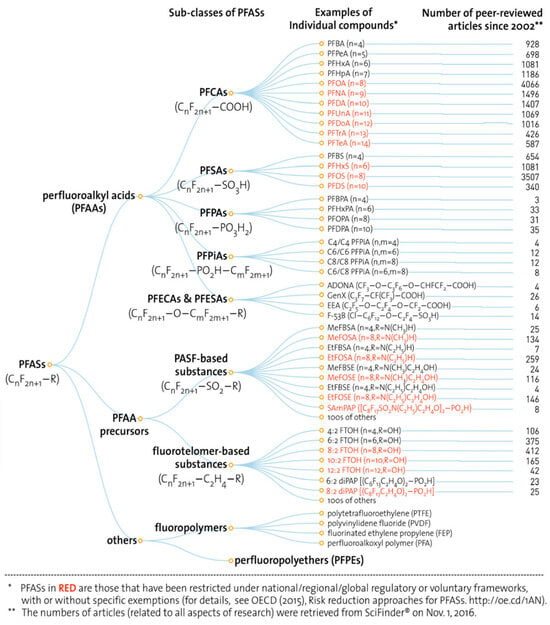
Figure 1
Open AccessArticle
Saccharide-Derived Zinc Oxide Nanoparticles with High Photocatalytic Activity for Water Decontamination and Sanitation
by
Kazi Afroza Sultana, Javier Hernandez Ortega, Md Tariqul Islam, Zayra N. Dorado, Bonifacio Alvarado-Tenorio, Ignacio Rene Galindo-Esquivel and Juan C. Noveron
Sustain. Chem. 2023, 4(4), 321-338; https://doi.org/10.3390/suschem4040023 - 03 Nov 2023
Cited by 1
Abstract
Zinc oxide nanoparticles (ZnO NPs) with a high photocatalytic performance were prepared by using the aerobic combustion of saccharides such as glucose, fructose, dextrin, and starch with zinc nitrate. The ZnO NPs were characterized by using transmission electron microscopy (TEM), scanning electron microscopy
[...] Read more.
Zinc oxide nanoparticles (ZnO NPs) with a high photocatalytic performance were prepared by using the aerobic combustion of saccharides such as glucose, fructose, dextrin, and starch with zinc nitrate. The ZnO NPs were characterized by using transmission electron microscopy (TEM), scanning electron microscopy (SEM), energy-dispersive X-ray scattering spectroscopy (EDX), X-ray powder diffraction (XRPD), and UV-vis spectroscopy. The TEM images revealed that the ZnO NPs have sizes ranging from ~20 to 35 nm with a bandgap of ~3.32 eV. The XRPD pattern revealed the hexagonal wurtzite crystalline structure of the ZnO NPs. The photocatalytic properties of the ZnO NPs were studied by the photocatalytic degradation of methyl orange (MO) in deionized water (DIW) and simulated fresh drinking water (FDW) under ultraviolet light (UV-B) and sunlight illumination. The terephthalic acid photoluminescence technique was also used to study the generation of a hydroxyl radical (•OH) by ZnO NPs. The saccharide-derived ZnO NPs exhibited higher photocatalytic activity than the nonsaccharide-derived ZnO NPs. Varying the type of saccharides used during the calcination had some effect on the degree of the catalytic enhancement.
Full article
(This article belongs to the Special Issue Efficient and Ecofriendly Chemical Synthesis of Advanced Materials for Energy and Environment)
►▼
Show Figures
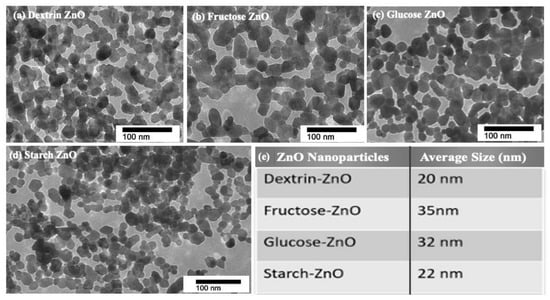
Figure 1
Open AccessArticle
High School Sustainable and Green Chemistry: Historical–Epistemological and Pedagogical Considerations
by
Teresa Celestino
Sustain. Chem. 2023, 4(3), 304-320; https://doi.org/10.3390/suschem4030022 - 14 Sep 2023
Cited by 1
Abstract
In this paper, a distinction is first made between environmental, sustainable, and green chemistry; the last two are then examined in relation to the more general problem of environmental education. A brief historical digression on the Science, Technology, and Society movement attempts to
[...] Read more.
In this paper, a distinction is first made between environmental, sustainable, and green chemistry; the last two are then examined in relation to the more general problem of environmental education. A brief historical digression on the Science, Technology, and Society movement attempts to dissect reasons why chemistry is seen by the general public as a problem, not as a decisive resource for the realization of the ecological transition. Although sustainable and green chemistry can be decisive in overcoming the insularity of chemical disciplines in high school, it is not well-embedded in educational practices. This situation is slowly changing thanks to the implementations of systems thinking in teaching practice, showing interconnections between the molecular world and sustainability. Historical and epistemological studies provide an all-encompassing framework for the relationship between chemistry and the environment in a broad sense, giving a solid foundation for educational projects. Specific operational goals can help chemical educators in supporting real learning, as well as an examination of the fundamental axes of sustainable and green chemistry, according to the criteria of Scientific and Technological Literacy. Finally, the results of some research carried out in secondary school are presented. These results demonstrate the effectiveness of the interdisciplinary-systemic approach in teaching chemistry as well as in guiding future green careers and reducing the gender gap, preparing high school students in the best possible way to face the challenges of an increasingly interconnected and complex world.
Full article
(This article belongs to the Collection New and Unconventional Strategies in Sustainable Chemistry Education at All Levels)
►▼
Show Figures
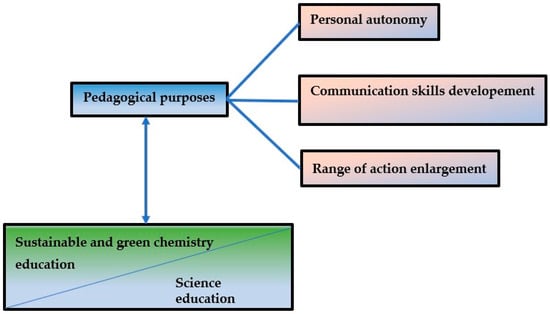
Figure 1
Open AccessArticle
Adding Sustainability in Analytical Chemistry Education through Monitoring Aquarium Water Quality
by
Noelia Rosales-Conrado and Juan Peña-Martínez
Sustain. Chem. 2023, 4(3), 282-303; https://doi.org/10.3390/suschem4030021 - 10 Aug 2023
Abstract
This paper introduces a captivating topic for upper-level analytical chemistry capstone projects, focusing on aquarium water analysis. This provides a more comprehensive understanding of the role of analytical chemistry towards sustainability and its environmental, economic, societal and education dimensions. Regarding the crucial role
[...] Read more.
This paper introduces a captivating topic for upper-level analytical chemistry capstone projects, focusing on aquarium water analysis. This provides a more comprehensive understanding of the role of analytical chemistry towards sustainability and its environmental, economic, societal and education dimensions. Regarding the crucial role of maintaining optimal aquarium water quality for the welfare of aquatic life, students are tasked with envisioning and executing the measurement of key parameters, including pH, ammonium, nitrite, and nitrate contents. This hands-on experience not only engages students in real-world applications, but also allows them to delve into essential analytical chemistry principles. They carefully select measurement methods, considering factors such as instrument availability, ease of use, precision and sensitivity requirements, sample size, and matrix effects. Besides fostering the acquisition of technical and soft skills, one notable aspect of this type of project is the exceptionally high student satisfaction. Furthermore, the project’s outcomes have proven to be significant predictors of learning achievements. Additionally, it lays the foundation for exploring potential designs of aquaponics systems and fosters interdisciplinary projects, expanding the practical applications in the field of chemistry education. Overall, these projects exemplify enriching and engaging educational experiences that empower students with valuable skills and knowledge while encouraging them to explore novel avenues in analytical chemistry.
Full article
(This article belongs to the Collection New and Unconventional Strategies in Sustainable Chemistry Education at All Levels)
►▼
Show Figures
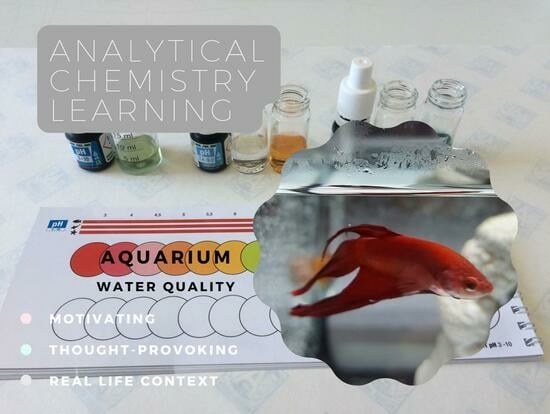
Graphical abstract
Open AccessArticle
Green and Sustainable Chemistry Teacher Education: Experiences from a Brazilian University
by
Caroindes J. C. Gomes and Vânia G. Zuin Zeidler
Sustain. Chem. 2023, 4(3), 272-281; https://doi.org/10.3390/suschem4030020 - 21 Jul 2023
Cited by 1
Abstract
Green and sustainable chemistry education provides opportunities to comprehend and base chemistry knowledge on relevant social and historical contexts, reflecting on fairer and sustainable realities. For this purpose, this work discusses the possibilities and challenges observed during a chemistry teacher training course at
[...] Read more.
Green and sustainable chemistry education provides opportunities to comprehend and base chemistry knowledge on relevant social and historical contexts, reflecting on fairer and sustainable realities. For this purpose, this work discusses the possibilities and challenges observed during a chemistry teacher training course at a Brazilian university, analyzing how the undergraduates utilized the formative experiences provided by the discipline and how they reinterpreted them when developing didactic sequences based on socio-scientific issues. Using discursive textual analysis, we studied the self-assessments and the didactic sequences produced. The activities developed were positively evaluated by the students and provided the opportunity to create didactic sequences with potential application in schools, founded on cooperative and democratic dynamics and topics that were locally important. On the other hand, the students had some difficulties including chemistry content, mainly considering their relationship with the topics addressed. However, the process proved to be fundamental for the students to perceive themselves as teachers, in addition to provoking them toward (re)constructions and other possibilities.
Full article
(This article belongs to the Collection New and Unconventional Strategies in Sustainable Chemistry Education at All Levels)
►▼
Show Figures

Figure 1
Open AccessReview
Recent Advances in Copper-Based Materials for Sustainable Environmental Applications
by
Sumalatha Bonthula, Srinivasa Rao Bonthula, Ramyakrishna Pothu, Rajesh K. Srivastava, Rajender Boddula, Ahmed Bahgat Radwan and Noora Al-Qahtani
Sustain. Chem. 2023, 4(3), 246-271; https://doi.org/10.3390/suschem4030019 - 15 Jul 2023
Cited by 4
Abstract
►▼
Show Figures
In recent years, copper-based nanomaterials have gained significant attention for their practical applications due to their cost-effectiveness, thermal stability, selectivity, high activity, and wide availability. This review focuses on the synthesis and extensive applications of copper nanomaterials in environmental catalysis, addressing knowledge gaps
[...] Read more.
In recent years, copper-based nanomaterials have gained significant attention for their practical applications due to their cost-effectiveness, thermal stability, selectivity, high activity, and wide availability. This review focuses on the synthesis and extensive applications of copper nanomaterials in environmental catalysis, addressing knowledge gaps in pollution management. It highlights recent advancements in using copper-based nanomaterials for the remediation of heavy metals, organic pollutants, pharmaceuticals, and other contaminants. Also, it will be helpful to young researchers in improving the suitability of implementing copper-based nanomaterials correctly to establish and achieve sustainable goals for environmental remediation.
Full article

Figure 1
Open AccessArticle
Sustainable Sawdust/Eucalyptol Absorption Matrix for Odor Slow-Release in Plywood Floor
by
Yuliya Logvina, Sónia Fernandes, Luís Pinto da Silva and Joaquim Esteves da Silva
Sustain. Chem. 2023, 4(3), 236-245; https://doi.org/10.3390/suschem4030018 - 12 Jul 2023
Abstract
►▼
Show Figures
A sustainable matrix based on eucalyptol essential oil/sawdust was developed and applied on laminated plywood. This finish aims to serve as a eucalyptol odor slow release. Eucalyptol odor release was monitored with gas chromatography coupled with a flame ionization detector (GC-FID: Limits of
[...] Read more.
A sustainable matrix based on eucalyptol essential oil/sawdust was developed and applied on laminated plywood. This finish aims to serve as a eucalyptol odor slow release. Eucalyptol odor release was monitored with gas chromatography coupled with a flame ionization detector (GC-FID: Limits of Detection and Quantification of 0.70 g/m3 and 2.11 g/m3, respectively, and with linearity up to 18.6 g/m3). Measurement of the eucalyptol odor released was performed during a six-month period, and it was found that the release followed a first-order exponential decay with a decay rate constant of 0.0169 per day. The half-life was determined to be of 48 days. The granulometry and particle size porosity of sawdust were analyzed by Scanning Electron Microscopy. A sawdust size fraction of 112–200 μm showed the best eucalyptol absorption capacity, with 1:3 masses ratio (sawdust:eucalyptol). The release duration of eucalyptol is influenced by the quantity of the eucalyptol–sawdust composite and the aperture size for release. Through the determination of this relationship, it was found that applying 15.0 g of the composite through a 0.8 mm diameter aperture resulted in a 6-month eucalyptol release period. This outcome is regarded as highly favorable, considering the inherent high volatility of eucalyptol and the relatively small amount of composite required for future product applications. The new product is characterized by a carbon footprint (considering the industry frontiers) of 5.94 kg CO2eq/m2 of plywood floor.
Full article

Figure 1
Open AccessArticle
Photoluminescent Copper Nanoclusters in “Turn-Off/Turn-On” Sensing of Picric Acid/Hydrogen Peroxide
by
Renuka Singh, Seema Gupta, Manoj Kumar Bharty, Chandra Shekhar Pati Tripathi and Debanjan Guin
Sustain. Chem. 2023, 4(2), 224-235; https://doi.org/10.3390/suschem4020017 - 01 Jun 2023
Cited by 1
Abstract
In this paper, we illustrate the synthesis, characterization, and application of a Bovine Serum Albumin-stabilized copper nanocluster (BSA@CuNCs)-based photoluminescence (PL) bifunctional sensor for the selective and rapid sensing of picric acid (PA) and hydrogen peroxide (H2O2). Blue-emitting copper nanoclusters
[...] Read more.
In this paper, we illustrate the synthesis, characterization, and application of a Bovine Serum Albumin-stabilized copper nanocluster (BSA@CuNCs)-based photoluminescence (PL) bifunctional sensor for the selective and rapid sensing of picric acid (PA) and hydrogen peroxide (H2O2). Blue-emitting copper nanoclusters were synthesized using one-pot synthesis at room temperature. The PL intensity of BSA@CuNCs was shown to be quenched (“Turn-off”) with an increase in the concentration of PA and intensified (“Turn-on”) with the addition of H2O2. The quenching of PL intensity of BSA@CuNCs was shown to be extremely selective and rapid towards PA. A linear decrease in the PL emission intensity of BSA@CuNCs was observed with a PA concentration in the range of 0–15 μM. An extremely low detection limit of 60 nM (3σ/k) was calculated. The as-prepared BSA@CuNCs also exhibited superior selectivity for PA detection in aqueous medium. The developed sensor was also utilized for the sensing of PA in natural water samples. The probe was found to be extremely sensitive towards the detection of H2O2. An increase in the PL intensity of BSA@CuNCs was seen with the addition of H2O2, with a detection limit of 0.11 μM.
Full article
(This article belongs to the Topic Green and Sustainable Chemistry)
►▼
Show Figures
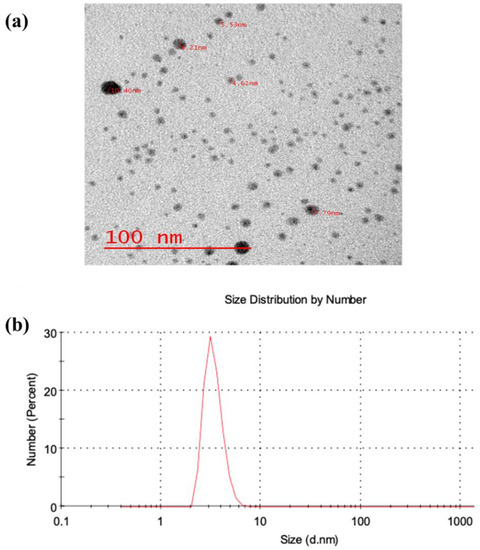
Figure 1
Open AccessArticle
Adsorption Characteristics of Cetirizine on Graphene Oxide
by
Tuhin Bhattacharjee, Arnab Bhattacharjee, Deepmoni Deka, Mihir Kumar Purkait, Devasish Chowdhury and Gitanjali Majumdar
Sustain. Chem. 2023, 4(2), 209-223; https://doi.org/10.3390/suschem4020016 - 30 May 2023
Cited by 1
Abstract
Water pollution caused by emerging contaminants such as pharmaceutical compounds is a growing problem worldwide. In this reported work, graphene oxide (GO) was directly used to remove an antihistamine drug, cetirizine. GO was prepared from graphite using a modified Hummer’s method and was
[...] Read more.
Water pollution caused by emerging contaminants such as pharmaceutical compounds is a growing problem worldwide. In this reported work, graphene oxide (GO) was directly used to remove an antihistamine drug, cetirizine. GO was prepared from graphite using a modified Hummer’s method and was characterized by UV–vis spectroscopy, Fourier-transformed infrared spectroscopy (FTIR), thermogravimetric analyzer (TGA), field scanning electron microscope (FE-SEM), transmission electron microscope (TEM), X-ray diffraction (XRD), etc. GO was demonstrated to be a highly efficient adsorbent for removing cetirizine from an aqueous solution. The adsorption of cetirizine on GO at various pH levels showed that in acidic pH with the adsorption shows faster kinetics and complete removal of cetirizine within 10 min, followed by neutral pH, which showed relatively slower kinetics but complete removal of cetirizine. However, at basic pH, GO could not completely remove cetirizine after 24 h. At a neutral pH, GO showed maximum adsorption of 81.30 mg g−1 of cetirizine. The adsorption isotherm results showed good agreement with the Langmuir isotherm. The BET surface area analysis showed the presence of mesoporosity in GO. In addition, the BET analysis further revealed a type IV isotherm curve being followed. A plausible mechanism is also discussed in the paper. The recyclability experiment demonstrates an adsorption efficiency of 85% after four cycles. The thermodynamic study reveals that adsorption is thermodynamically less favorable at higher temperatures. Hence, the current study successfully demonstrates the use of GO as an efficient adsorbent in removing cetirizine. It also studies the various factors and interactions affecting adsorption. Thus, this study sheds light on the adsorption characteristics of cetirizine on graphene oxide.
Full article
(This article belongs to the Topic Green and Sustainable Chemistry)
►▼
Show Figures

Figure 1
Open AccessArticle
Lysine-Based Silicone Surfactants
by
Abygail Camacho Ramirez, Miguel Melendez-Zamudio, Antonio Guerra Contreras and Michael A. Brook
Sustain. Chem. 2023, 4(2), 197-208; https://doi.org/10.3390/suschem4020015 - 04 May 2023
Cited by 2
Abstract
Highly efficient silicone surfactants are typically based on polyether hydrophiles. As part of a program to increase the natural content of silicones, we describe the synthesis of silicone surfactants with amino acid hydrophiles (cysteine, arginine, and lysine). The compounds were prepared using a
[...] Read more.
Highly efficient silicone surfactants are typically based on polyether hydrophiles. As part of a program to increase the natural content of silicones, we describe the synthesis of silicone surfactants with amino acid hydrophiles (cysteine, arginine, and lysine). The compounds were prepared using a radial thiol–ene reaction with vinylsilicones for cysteine derivatives and a catalyst-free aza-Michael reaction with arginine and lysine. Short chain surfactants with silicone monomer:hydrophile ratios of 5:1 or less (e.g., telechelic silicones of lysine-linker-(Me2OSi)n-linker-lysine n = 10) were ineffective at stabilizing emulsions of silicone oil (D4): water. However, excellent surfactants were realized as the chain length (n) increased to 25 or 50, stabilizing water-in-oil emulsions with high water content (80% or 90%). The surfactants, especially the longer chain compounds, were stable against pH except <4 or >9 and survived freeze/thaw cycles. These surfactants contain 12–25% natural materials, improving their sustainability compared to those containing synthetic hydrophiles.
Full article
(This article belongs to the Topic Green and Sustainable Chemistry)
►▼
Show Figures
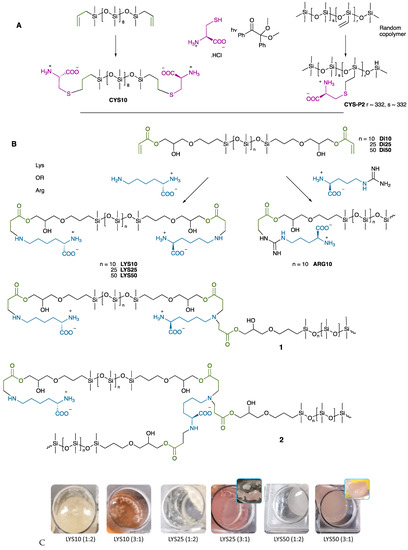
Figure 1
Open AccessCommunication
Bio-Based Chemicals from Dedicated or Waste Biomasses: Life Cycle Assessment for Evaluating the Impacts on Land
by
Daniele Cespi
Sustain. Chem. 2023, 4(2), 184-196; https://doi.org/10.3390/suschem4020014 - 26 Apr 2023
Cited by 1
Abstract
►▼
Show Figures
Green chemistry and engineering encourage the usage of renewable sources, in replacement fossil fuels. The sector of bio-based products is one of the most predominant examples of such replacements in different fields. However, the impact of biomasses usage is far from being negligible
[...] Read more.
Green chemistry and engineering encourage the usage of renewable sources, in replacement fossil fuels. The sector of bio-based products is one of the most predominant examples of such replacements in different fields. However, the impact of biomasses usage is far from being negligible or net zero. A life cycle perspective is required in order to assess all the different environmental impacts related to biomass exploitation and usage, in particular when dedicated sources are used. This study points out the importance of including the results of a Life Cycle Assessment (LCA) early in the design of new bio-based products, to identify the stage of the value chain with the greatest hotspots and set proper eco-design strategies. At the same time, the use of the LCA results may support purchasing activities through comparing products with different burdens. In this manuscript, a focus on land compartment is carried out, given its relevance to the cultivation phase. Five analysis methods are selected for further description. Three are classified as multi-impact approach methodologies (ReCiPe 2016, IMPACT World + and EF 3.0) since they are able to translate mass and energy balances into several impact categories at the same time, not only those on land comparts which are also included. In addition, the LANCA® model and the True pricing method for agri-food products are discussed, underlining the importance of their usage when a detailed review of the impact on soil is necessary (e.g., during an environmental impact assessment). They are compared in this paper, underlining the main differences and potential fields of application.
Full article
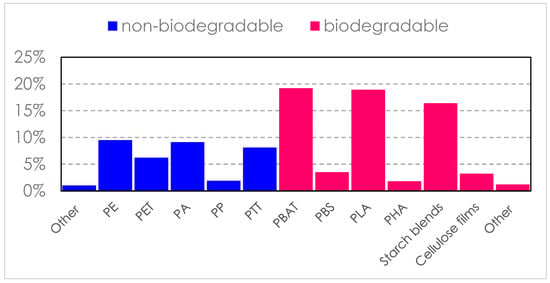
Figure 1
Open AccessOpinion
Microfluidics for Polymer Microparticles: Opinion on Sustainability and Scalability
by
Hassan El Itawi, Sami Fadlallah, Patrick Perré and Florent Allais
Sustain. Chem. 2023, 4(2), 171-183; https://doi.org/10.3390/suschem4020013 - 10 Apr 2023
Abstract
The microfluidic production of simple (microspheres) and core–shell (microcapsules) polymer microparticles, often called microencapsulation, has been the scope of several research works since the 1980s. It is a fast, thrifty, and efficient process because of its controlled properties, tuneability, and yield, which can
[...] Read more.
The microfluidic production of simple (microspheres) and core–shell (microcapsules) polymer microparticles, often called microencapsulation, has been the scope of several research works since the 1980s. It is a fast, thrifty, and efficient process because of its controlled properties, tuneability, and yield, which can reach 100%. However, the question of its greenness, sustainability, and scalability remains unclear, and more awareness/education is required in this field. The sustainability of production processes using microfluidic techniques can be realized/discussed based on three pillars: (i) waste generation, (ii) the solvents employed, and (iii) raw materials. On the other hand, although the scaling-up of these processes was reported on in several papers as procedures in which hundreds or thousands of microfluidic chips are set in parallel, the sustainability of this scale-up has not been addressed to our knowledge. This opinion paper highlights the advantages of microfluidic encapsulation processes, their greenness according to the above-mentioned pillars, (i–iii) and the necessary considerations to scale them up while preserving their sustainability.
Full article
(This article belongs to the Topic Green and Sustainable Chemistry)
►▼
Show Figures

Figure 1
Highly Accessed Articles
Latest Books
E-Mail Alert
News
Topics
Topic in
Polymers, Polysaccharides, Sustainability, Sustainable Chemistry, Molecules
Polymers from Renewable Resources, 2nd Volume
Topic Editors: Valentina Siracusa, Nadia Lotti, Michelina Soccio, Alexey L. IordanskiiDeadline: 31 May 2024
Topic in
C, Energies, Processes, Sustainable Chemistry
Final Sinks of Carbon Capture, Utilization and Storage (CCUS)
Topic Editors: Rafael Santos, Muhammad Salman, Lidija SillerDeadline: 30 July 2024
Topic in
Materials, Polymers, Sustainable Chemistry, Molecules
Advances in Bio-Sourced Molecules and Materials in Civil Engineering
Topic Editors: Patrick M. Martin, Vincent DuboisDeadline: 31 August 2024
Topic in
Catalysts, Chemistry, Molbank, Molecules, Sustainable Chemistry
Towards the Sustainable Synthesis of Biologically Active Molecules in Green Solvents
Topic Editors: Antonio Salomone, Serena PerroneDeadline: 31 December 2024

Conferences
Special Issues
Special Issue in
Sustainable Chemistry
Innovations in Energy Engineering and Cleaner Production: A Sustainable Chemistry Perspective
Guest Editors: Francesca Deganello, Jan-Willem BosDeadline: 30 November 2024
Topical Collections
Topical Collection in
Sustainable Chemistry
Heterogeneous Catalysts Applied in Sustainable Chemistry
Collection Editor: James A. Sullivan
Topical Collection in
Sustainable Chemistry
New and Unconventional Strategies in Sustainable Chemistry Education at All Levels
Collection Editors: Francesca Deganello, James A. Sullivan




